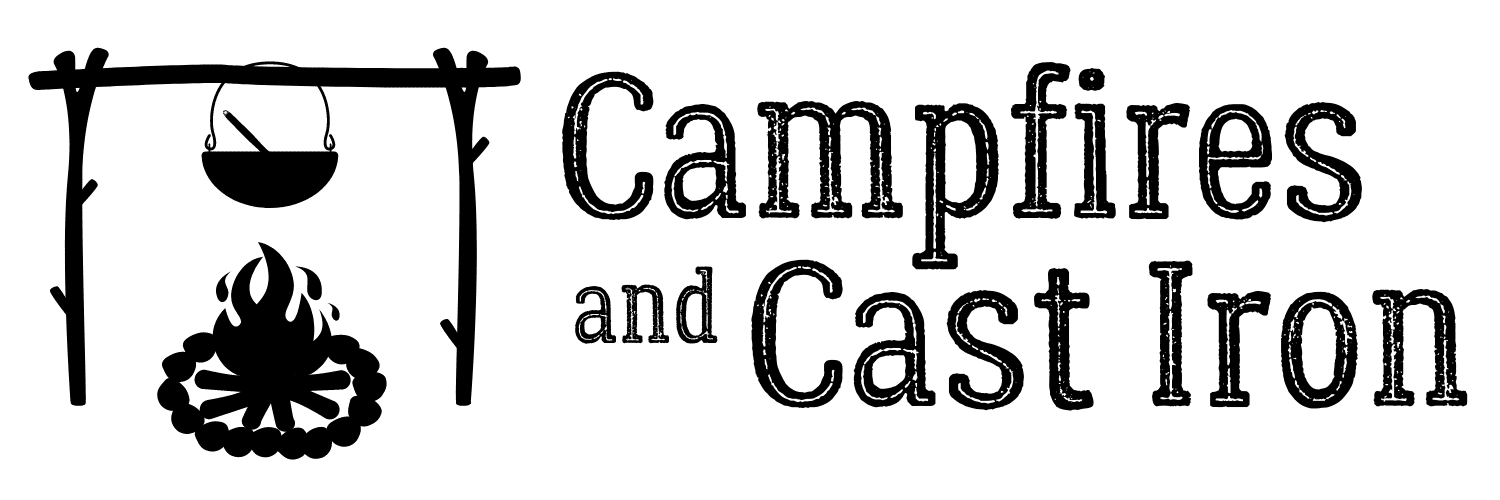You just finished enjoying a delicious meal cooked in your cast iron skillet. Now, it’s time to wash the dishes. After cleaning and drying your skillet, you wonder, “Am I supposed to oil cast iron cookware after I use it?”
I hear this question a lot, along with these others:
- Is oiling cast iron the same thing as seasoning it?
- What happens if I don’t put oil on my skillet after each use?
- How do I correctly oil my cast iron cookware?
- Won’t leaving oil on my pan make it feel sticky?
In short, it’s best to apply a very light coating of oil to clean, dry cast iron cookware after each use. The oil protects the iron from moisture and oxidation, which helps prevent rust. Apply cooking oil with a clean, lint-free cloth, then thoroughly wipe down all surfaces of the pan to remove excess oil.
Let’s take a more in-depth look at why you should oil cast iron cookware after every use, how to correctly oil cast iron, and why oiling and seasoning are very different things.
Why You Should Oil Cast Iron Cookware After Every Use
As mentioned briefly above, oiling cast iron cookware after using it helps protect the iron from rust. Cast iron is naturally a very porous material, meaning it has tons of microscopic “pores,” or holes. These pores tend to trap moisture and make the iron susceptible to rust.
This is why it’s very important to make sure cast iron cookware is always dried thoroughly after washing it. Then, by applying a very thin coating of cooking oil to all surfaces of the pan, the oil seeps into the pores and prevents moisture from entering. This protects the iron and significantly decreases the chances of your pan rusting.
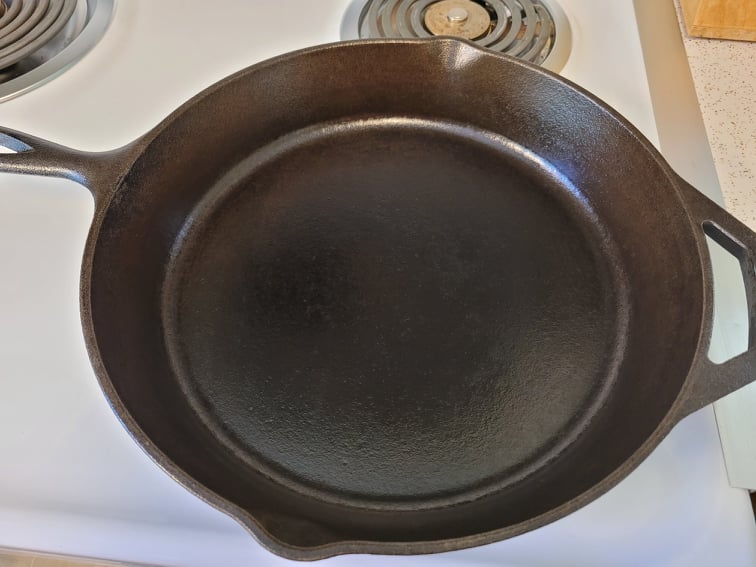
Is Oiling The Same As Seasoning Cast Iron?
Oiling and seasoning cast iron are not the same thing. When oiling a pan after use, you are simply applying a very light coat of oil to the iron, rubbing it in, and buffing it off. The pan is then ready to store.
Seasoning cast iron involves applying oil in the same manner, but then the pan is heated in an oven at a high temperature for an hour. During this heating process, the oil undergoes a chemical reaction called polymerization, which essentially causes the liquid oil to bond with the iron on a molecular level and transform into a slick, hard surface. Correctly seasoning a cast iron pan requires three to four rounds of oiling and heating.
For everything you need to know about seasoning cast iron, check out this article, Seasoning Cast Iron Cookware: A Step-By-Step Guide.
Do You Have To Season Cast Iron After Every Use?
No, you don’t need to season cast iron cookware after every use. Once it has been seasoned initially, it really only needs to be seasoned again a few times per year.
Typically, a cast iron pan with a strong base layer of seasoning will continue to improve with use over time. However, you may need to re-season if:
- The pan is beginning to appear a rusty or dull grey color, or if you notice flaking.
- Food is sticking to the pan despite the use of cooking oil.
- You’ve recently scoured the pan with an abrasive pad and removed part of the seasoning layer.
- If you’ve cooked acidic foods for a long period of time (like simmering marinara sauce), as this can eat away at the seasoning layer.
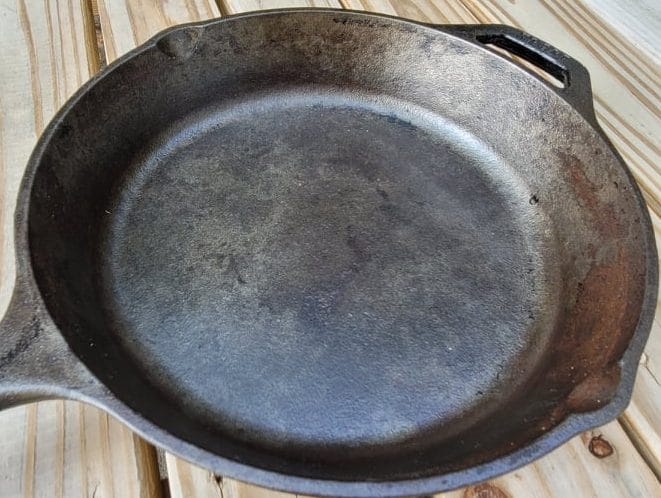
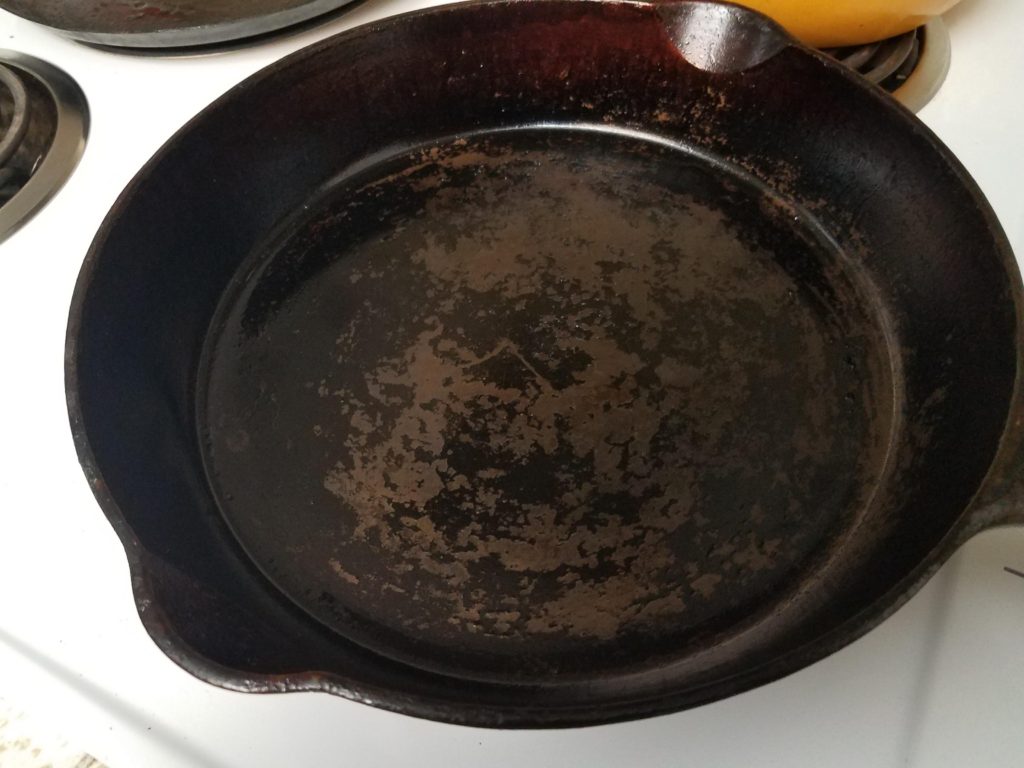
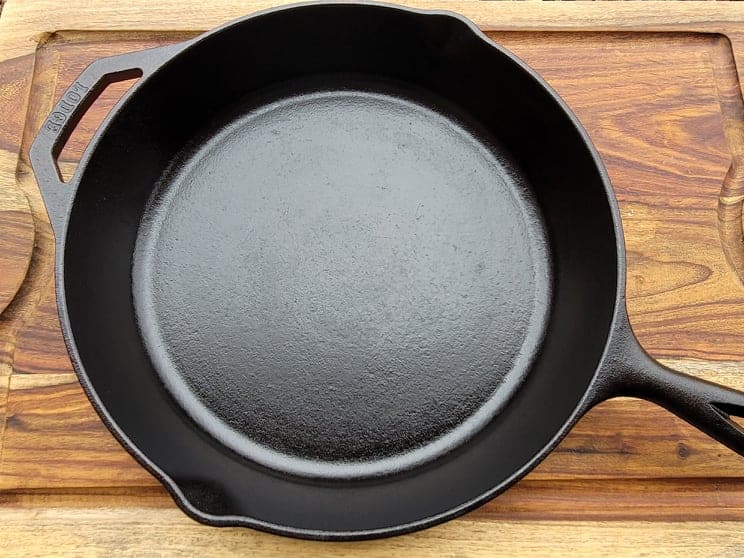
How To Care For Cast Iron After Each Use
After cooking with a cast iron pan, follow these three easy steps to clean and maintain your cookware for years to come.
Wash The Pan
Wash the pan to remove leftover food residue and grease. You can simply wash it with water and a sponge, or you can use mild dish soap. It’s a common misconception that you can’t use soap to clean cast iron. Many years ago, dish soap was lye-based and would literally dissolve the seasoning layer. Today’s soaps are formulated much differently and won’t harm cast iron seasoning.
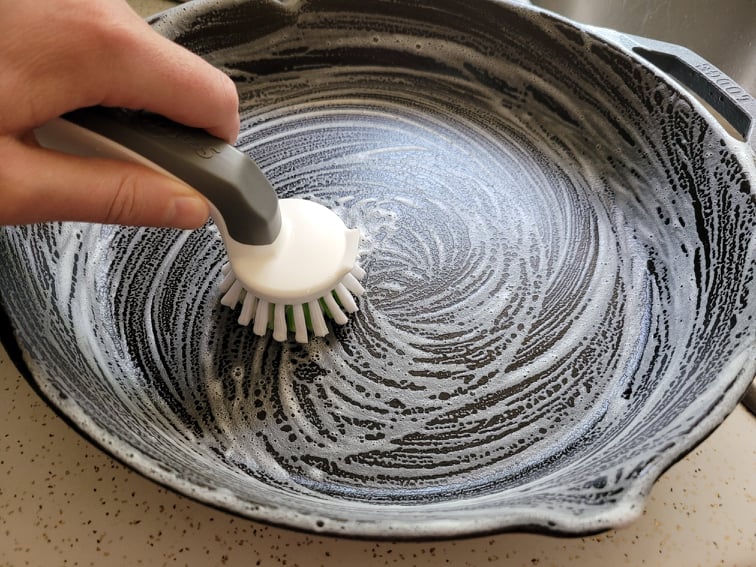
To help remove stubborn, stuck-on food without damaging your pan, I recommend using pan scrapers, polymer sponges, chainmail scrubbers, or a stiff-bristled brush made specifically for cleaning cast iron.
To ease any concerns about cast iron cookware being sanitary if you only wash it with water, check out my article, Are Cast Iron Pans Sanitary? The Science Behind The Answer. The results of this experiment were really interesting!
Dry The Pan Thoroughly
After washing your pan, make sure to dry it completely. Never let cast iron drip dry, or it will rust fairly quickly.
The best way to ensure cast iron is completely dry is to wipe it off with a towel, then heat it on a stove burner or in the oven on a medium heat setting for a few minutes. Any moisture in the iron will evaporate and leave behind a clean, dry surface.
Oil The Pan
Next, use a lint-free cloth to rub a very light coat of any type of cooking oil all over the inside and outside of the pan. A little bit goes a really long way! Try to avoid using paper towels to rub the oil in because tiny paper fibers end up getting caught all over the rough surface of the iron (Trust me on this one!).
After applying the oil, take another clean, lint-free cloth and buff all surfaces of the pan to remove excess oil. You want to wipe it off really well, as if you’re trying to remove all the oil you just applied. There will still be plenty of oil in the tiny pores of the iron to protect it from rust. Leaving too much oil on the iron will cause it to feel sticky over time.
How To Store Cast Iron Cookware Between Uses
After cooking a delicious meal with your cast iron skillet, dutch oven, or griddle, you’ll want to make sure it is properly cleaned, stored, and ready for use by following these guidelines:
- Make sure each cast iron piece is completely clean and dry. Re-season pans if needed, or wipe them down with a very light coating of oil as described above to protect the iron from moisture and oxidation.
- Store cookware in a cabinet, on the stovetop, on a hanging rack, or in a box or storage bag. Store dutch ovens and skillets with the lids off. This will allow air to circulate and decrease the chances of rusting.
- Always store cast iron away from sources of moisture. For example, don’t stack skillets in a cabinet next to the sink or dishwasher.
- Be cautious about storing cast iron cookware in campers, storage units, or tote boxes outdoors. Humidity contributes to rust.
Conclusion
Now that you know how to properly clean, oil, and store your cast iron cookware, it’s time to get cooking! Be sure to check out the Recipes section of the blog for delicious and easy recipes you can cook while camping or at home, complete with allergy-friendly modification instructions.
This post may contain affiliate links. This means if you click on a link and make a purchase, I will receive a small commission, at no cost to you, that makes it possible for me to keep the Campfires and Cast Iron site up and running. Please see our disclosure policy for details.
